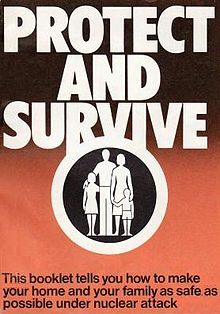In last week’s blog post I talked about my visit to the Kelvedon Hatch, a 1950s bunker that was decommissioned in the mid 90s and turned into a tourist attraction. Much to my amazement and delight the bunker had a gift shop by the exit and, although I forced myself to return various brightly coloured erasers, pencils and notepads to the shelves, I did allow myself to purchase a copy of the Protect and Survive booklet.
The booklet was intended to be distributed for free to everyone in the country upon the threat of a nuclear attack. Its intentions were to inform the public on protocol in the event of war and also to describe the consequences of a nuclear bomb if one were to hit the UK.
Although the idea behind its creation and distribution seems honourable enough, after a few pages it soon becomes apparent that the whole thing is a mere placebo to calm the public before their inevitable death. But at least the government seemed to be doing something to help, right?
Even from the introduction of the booklet it states that nuclear explosions completely destroy and contaminate land for miles and miles surrounding the area of the blast…but then it promptly details ways in which the local people can protect themselves using boxes and blankets in their homes. Already these blatant contradictions seem obvious, but maybe that’s just with hindsight?
One point that is continually stressed throughout is that everyone is to remain at home. It warns that anyone who leaves will not be offered food or shelter and abandoned houses will soon be taken up by the local authorities. Families should therefore take measures to create ‘fall-out rooms’ in their homes to protect themselves from the dangers of nuclear fall-out.
Of course no amount of amateur DIYing could protect a human being from a nuclear blast. The instructions provided are vague and lazy, only logical if the danger in question were a bomb from WWII. The entire booklet tries to emulate this wartime spirit but it does so without any real heart, maybe because this type of war would require more than good ol’ British stubbornness to be won.
As an afterthought to building a refuge in the home, the booklet mentions how bungalows, top-floor flats and caravans may not be ideal in regards to protecting oneself from a nuclear explosion. However, it then goes on to say if there are no other options then….well, you’ll just have to make do and see if you survive, they suppose. Apparently the local authorities would have helped, but of course everyone was to remain in their homes until instructed otherwise.
But what if you’re outside when the attack happens? No problem! The booklet says you just have to jump in a ditch and cover any bare skin with your coat. If your coat happens to be a refrigerator I’m sure that’d be fine.
Perhaps my favourite quote from the whole booklet is:
If a death occurs while you are confined to the fall-out room place the body in another room and cover it as securely as possible. Attach an identification.
So grandma just died? No time for grieving, just hook a tag on her toe with her name and get back into the fall-out room.
There is so much emphasis on identification in the booklet that is painfully obvious what is going on: the government needed a simple way to identify bodies should the war build momentum, and what better way than get the corpses to mark their own graves? The death count would have been innumerable, so the public were to wait in their own personal body bag shelters with suitable identification until collected.
Although the whole thing seems so ridiculous it is almost humorous, this was the only preparation British citizens were going to be given. On the other hand, what else could have been done without causing mass panic?
This booklet is a perfect snippet of a disturbing yet fascinating time in our history. I really recommend that all homes have Protect and Survive, even if it’s just to remind ourselves of our own helplessness.




Leave a Reply